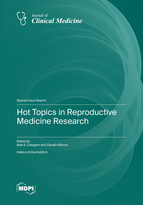Hot Topics in Reproductive Medicine Research
A special issue of Journal of Clinical Medicine (ISSN 2077-0383). This special issue belongs to the section "Reproductive Medicine & Andrology".
Deadline for manuscript submissions: closed (15 November 2023) | Viewed by 54196
Special Issue Editors
Interests: endocrinology of reproduction and sexuality
Special Issues, Collections and Topics in MDPI journals
2. Department of Biomedicine and Prevention, University of Rome “Tor Vergata”, Rome, Italy
Interests: assisted reproduction; preimplantation genetic tests for aneuploidies; infertility; male infertility; obstetric outcome; polycystic ovarian syndrome; endometrium; endometriosis
Special Issue Information
Dear Colleagues,
Infertility affects approximately 10–15% of couples of reproductive age worldwide. Several factors contribute to its increasing trend in Western countries. Unfortunately, the etiology of infertility remains elusive in a high proportion of patients and therefore the treatments are poorly effective.
Additionally, the results of assisted reproductive techniques (ARTs) show evident limitations even using pre-implantation genetic diagnosis for aneuploidies, prolonged embryo cultures, selection of embryos, etc. Furthermore, there are concerns about obstetric, neonatal, and adult health risks of the children obtained by ART. The endometrium and the placenta certainly deserve more attention. Despite the growing trend in the use of ART, very frequent conditions, such as inflammation of the male genital tract and varicocele, female diseases such as polycystic ovarian syndrome and endometriosis, and their treatments cannot be underestimated.
Another important aspect is the selection of embryos to be used for embryo transfer after ART. Considering the multifactorial aspects involved in reproduction, new approaches are being studied to select the “best” ones in terms of reproductive success. These include the use of artificial intelligence.
This Special Issue aims to focus on some hot issues in reproductive medicine and to re-evaluate infertility etiology, the available clinical-therapeutic strategies (including ART), and decision-making algorithms in the light of the most recent evidence.
Prof. Dr. Aldo E. Calogero
Prof. Dr. Claudio Manna
Guest Editors
Manuscript Submission Information
Manuscripts should be submitted online at www.mdpi.com by registering and logging in to this website. Once you are registered, click here to go to the submission form. Manuscripts can be submitted until the deadline. All submissions that pass pre-check are peer-reviewed. Accepted papers will be published continuously in the journal (as soon as accepted) and will be listed together on the special issue website. Research articles, review articles as well as short communications are invited. For planned papers, a title and short abstract (about 100 words) can be sent to the Editorial Office for announcement on this website.
Submitted manuscripts should not have been published previously, nor be under consideration for publication elsewhere (except conference proceedings papers). All manuscripts are thoroughly refereed through a single-blind peer-review process. A guide for authors and other relevant information for submission of manuscripts is available on the Instructions for Authors page. Journal of Clinical Medicine is an international peer-reviewed open access semimonthly journal published by MDPI.
Please visit the Instructions for Authors page before submitting a manuscript. The Article Processing Charge (APC) for publication in this open access journal is 2600 CHF (Swiss Francs). Submitted papers should be well formatted and use good English. Authors may use MDPI's English editing service prior to publication or during author revisions.
Keywords
- assisted reproduction
- preimplantation genetic tests for aneuploidies
- infertility
- male infertility
- obstetric outcome
- polycystic ovarian syndrome
- endometrium
- endometriosis








